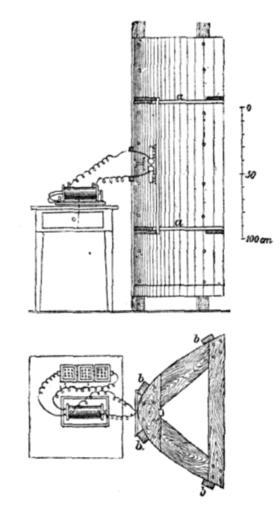MAKE A MEME
View Large Image

| View Original: | Hertz_spark_gap_transmitter_and_parabolic_antenna.png (506x926) | |||
| Download: | Original | Medium | Small | Thumb |
| Courtesy of: | commons.wikimedia.org | More Like This | ||
| Keywords: Hertz spark gap transmitter and parabolic antenna.png spark-gap radio transmitter and parabolic antenna used by German physicist Heinrich Hertz in 1888 during his historic first researches on radio waves Hertzian waves from his 1893 book This is the earliest example of a parabolic antenna The antenna is described on p 175 of the source as a 2 m x 2 m sheet of zinc attached to a wooden frame to make a cylindrical parabolic reflector with aperture 2 m high by 1 2 m wide with focal length of 12 5 cm Along the focal line is suspended a Hertzian dipole antenna consisting of two 1 cm dia brass rods about 13 cm long with metal balls attached to its adjacent ends to make a spark gap about 3 mm wide The dipole elements were attached to an induction coil powered by a battery on a table behind the antenna which applied high voltage pulses which caused sparks in the spark gap exciting high frequency oscillations in the dipole The wavelength of the waves produced was measured by Hertz at 66 cm making the corresponding frequency 454 MHz <br /> Hertz used a similar parabolic antenna with a spark gap for receiving With these he performed historic experiments demonstrating standing waves diffraction refraction and polarization of radio waves proving that radio waves are electromagnetic waves like light waves thus confirming the 1867 theory of James Clerk Maxwell 1893 Downloaded 2011-12-07 from http //books google com/books id d_dUAAAAMAAJ pg PA183 Heinrich Hertz Daniel Evan Jones 1893 Electric Waves 2nd Ed McGraw-Hill New York p 183 fig 35 on Google Books Creator Heinrich Hertz Public domain - Hertz died in 1894 PD-old-100 Uploaded with UploadWizard Spark-gap transmitters Parabolic antennas Heinrich Rudolf Hertz ImageNote 1 231 63 181 477 506 926 2 Parabolic reflector made of zinc sheet metal attached to wooden frame focuses radio waves from dipole into beam ImageNoteEnd 1 ImageNote 2 249 234 57 130 506 926 2 Dipole antenna made of two 13 cm brass rods with spark gap between them When high voltage from coil jumps the gap it creates a pulse of radio waves ImageNoteEnd 2 ImageNote 3 77 327 125 51 506 926 2 Induction coil Ruhmkorff coil powered by battery creates pulses of high voltage electricity ImageNoteEnd 3 ImageNote 4 105 652 107 46 506 926 2 Battery to power induction coil ImageNoteEnd 4 ImageNote 5 96 706 116 79 506 926 2 Induction coil Ruhmkorff coil generates pulses of high voltage electricity from the low voltage provided by battery ImageNoteEnd 5 ImageNote 6 244 601 167 286 506 926 2 Parabolic reflector made of zinc sheet metal attached to wooden frame focuses radio waves from dipole antenna into a beam ImageNoteEnd 6 | ||||